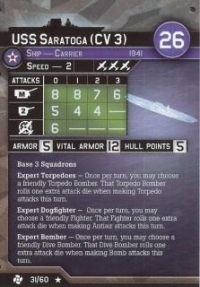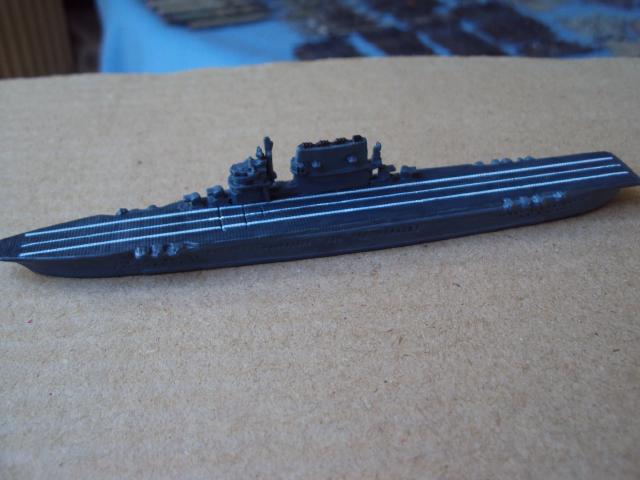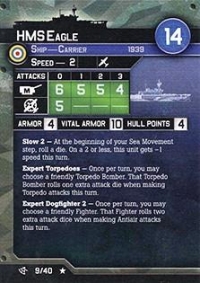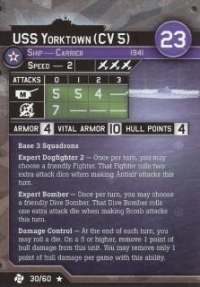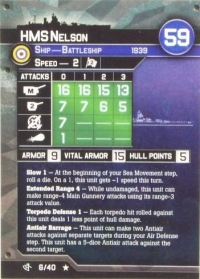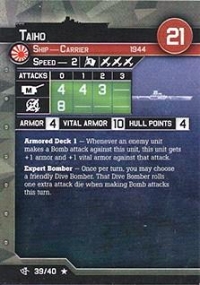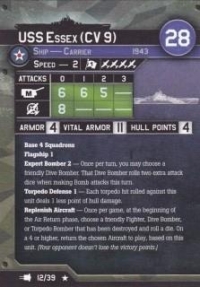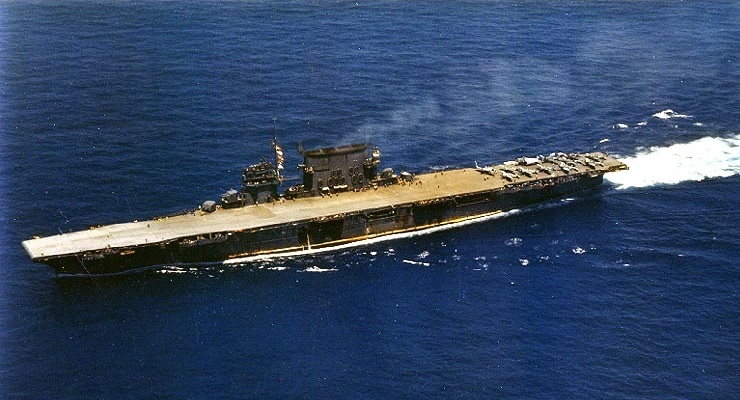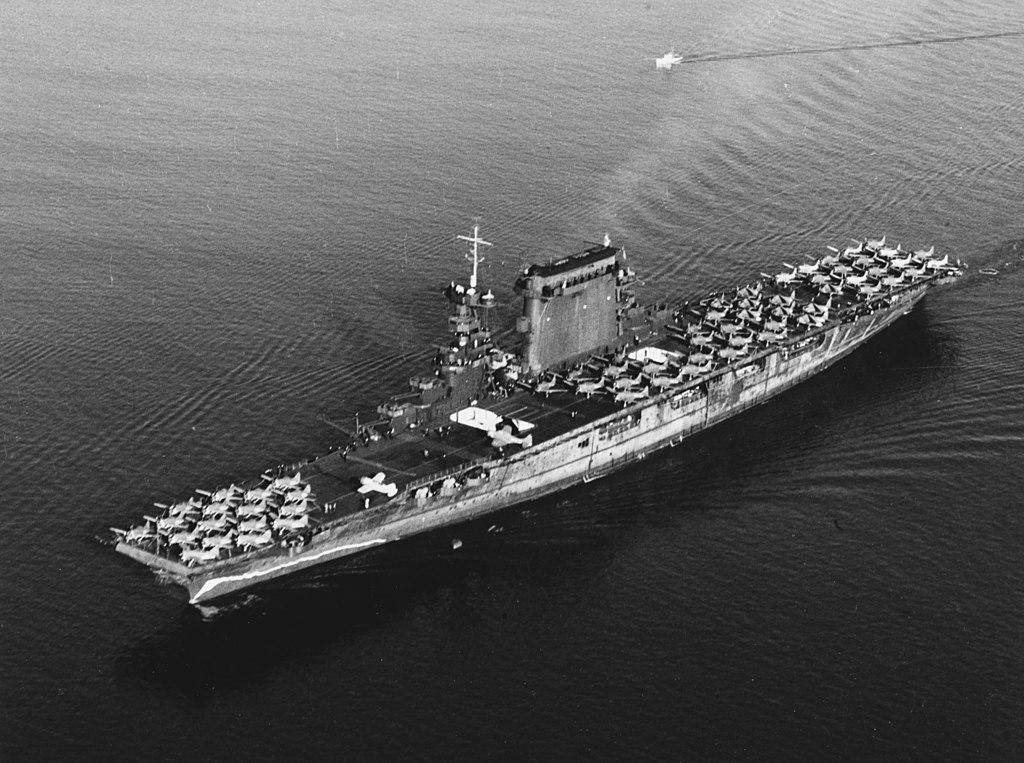Prototype: USS Saratoga (CV-3) was a Lexington-class aircraft carrier built for the United States Navy during the 1920s. Originally designed as a battlecruiser, she was converted into one of the Navy's first aircraft carriers during construction to comply with the Washington Naval Treaty of 1922. The ship entered service in 1928 and was assigned to the Pacific Fleet for her entire career. Saratoga and her sister ship, Lexington, were used to develop and refine carrier tactics in a series of annual exercises before World War II. On more than one occasion these exercises included successful surprise attacks on Pearl Harbor, Hawaii. She was one of three prewar US fleet aircraft carriers, along with Enterprise and Ranger, to serve throughout World War II.
Shortly after the Japanese attack on Pearl Harbor, Saratoga was the centerpiece of the unsuccessful American effort to relieve Wake Island and was torpedoed by a Japanese submarine a few weeks later. After lengthy repairs, the ship supported forces participating in the Guadalcanal Campaign and her aircraft sank the light carrier Ryūjō during the Battle of the Eastern Solomons in August 1942. She was again torpedoed the following month and returned to the Solomon Islands area after repairs were completed.
In 1943, Saratoga supported Allied forces involved in the New Georgia Campaign and invasion of Bougainville in the northern Solomon Islands and her aircraft twice attacked the Japanese base at Rabaul in November. Early in 1944, her aircraft provided air support during the Gilbert and Marshall Islands Campaign before she was transferred to the Indian Ocean for several months to support the British Eastern Fleet as it attacked targets in Java and Sumatra. After a brief refit in mid-1944, the ship became a training ship for the rest of the year.
In early 1945, Saratoga participated in the Battle of Iwo Jima as a dedicated night fighter carrier. Several days into the battle, she was badly damaged by kamikaze hits and was forced to return to the United States for repairs. While under repair, the ship, now increasingly obsolete, was permanently modified as a training carrier with some of her hangar deck converted into classrooms. Saratoga remained in this role for the rest of the war and was then used to ferry troops back to the United States after the Japanese surrender in August. In mid-1946, the ship was a target for nuclear weapon tests during Operation Crossroads. She survived the first test with little damage, but was sunk by the second test.
Shortly after the Japanese attack on Pearl Harbor, Saratoga was the centerpiece of the unsuccessful American effort to relieve Wake Island and was torpedoed by a Japanese submarine a few weeks later. After lengthy repairs, the ship supported forces participating in the Guadalcanal Campaign and her aircraft sank the light carrier Ryūjō during the Battle of the Eastern Solomons in August 1942. She was again torpedoed the following month and returned to the Solomon Islands area after repairs were completed.
In 1943, Saratoga supported Allied forces involved in the New Georgia Campaign and invasion of Bougainville in the northern Solomon Islands and her aircraft twice attacked the Japanese base at Rabaul in November. Early in 1944, her aircraft provided air support during the Gilbert and Marshall Islands Campaign before she was transferred to the Indian Ocean for several months to support the British Eastern Fleet as it attacked targets in Java and Sumatra. After a brief refit in mid-1944, the ship became a training ship for the rest of the year.
In early 1945, Saratoga participated in the Battle of Iwo Jima as a dedicated night fighter carrier. Several days into the battle, she was badly damaged by kamikaze hits and was forced to return to the United States for repairs. While under repair, the ship, now increasingly obsolete, was permanently modified as a training carrier with some of her hangar deck converted into classrooms. Saratoga remained in this role for the rest of the war and was then used to ferry troops back to the United States after the Japanese surrender in August. In mid-1946, the ship was a target for nuclear weapon tests during Operation Crossroads. She survived the first test with little damage, but was sunk by the second test.
Class History: The Lexington-class aircraft carriers were a pair of aircraft carriers built for the United States Navy (USN) during the 1920s. The ships were built on hulls originally laid down as battlecruisers after World War I, but under the Washington Naval Treaty of 1922, all U.S. battleship and battlecruiser construction was cancelled. The Treaty, however, allowed two of the unfinished ships to be converted to carriers. They were the first operational aircraft carriers in the USN and were used to develop carrier aviation tactics and procedures before World War II in a series of annual exercises.
They proved extremely successful as carriers and experience with the Lexington class convinced the Navy of the value of large carriers. They were the largest aircraft carriers in the USN until the Midway-class aircraft carriers were completed beginning in 1945. The ships served in World War II, seeing action in many battles. Although Lexington was sunk in the first carrier battle in history (the Battle of the Coral Sea) in 1942, Saratoga served throughout the war, despite being torpedoed twice, notably participating in the Battle of the Eastern Solomons in mid-1942 where her aircraft sank the Japanese light carrier Ryūjō. She supported Allied operations in the Indian Ocean and South West Pacific Areas until she became a training ship at the end of 1943. Saratoga returned to combat to protect American forces during the Battle of Iwo Jima in early 1945, but was badly damaged by kamikazes. The continued growth in the size and weight of carrier aircraft made her obsolete by the end of the war. In mid-1946, the ship was sunk during nuclear weapon tests in Operation Crossroads.
They proved extremely successful as carriers and experience with the Lexington class convinced the Navy of the value of large carriers. They were the largest aircraft carriers in the USN until the Midway-class aircraft carriers were completed beginning in 1945. The ships served in World War II, seeing action in many battles. Although Lexington was sunk in the first carrier battle in history (the Battle of the Coral Sea) in 1942, Saratoga served throughout the war, despite being torpedoed twice, notably participating in the Battle of the Eastern Solomons in mid-1942 where her aircraft sank the Japanese light carrier Ryūjō. She supported Allied operations in the Indian Ocean and South West Pacific Areas until she became a training ship at the end of 1943. Saratoga returned to combat to protect American forces during the Battle of Iwo Jima in early 1945, but was badly damaged by kamikazes. The continued growth in the size and weight of carrier aircraft made her obsolete by the end of the war. In mid-1946, the ship was sunk during nuclear weapon tests in Operation Crossroads.
Country: The U.S. is a country of 50 states covering a vast swath of North America, with Alaska in the northwest and Hawaii extending the nation’s presence into the Pacific Ocean. Major Atlantic Coast cities are New York, a global finance and culture center, and capital Washington, DC. Midwestern metropolis Chicago is known for influential architecture and on the west coast, Los Angeles' Hollywood is famed for filmmaking.
Item created by: Lethe on 2015-05-31 17:46:30. Last edited by gdm on 2019-07-02 06:15:22
If you see errors or missing data in this entry, please feel free to log in and edit it. Anyone with a Gmail account can log in instantly.
If you see errors or missing data in this entry, please feel free to log in and edit it. Anyone with a Gmail account can log in instantly.


